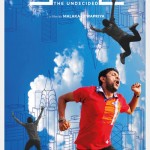A mirror reflecting the spirit of the left bank in an unstructured and modernist approach
View(s):By Dr. Dharmasena Pathiraja
Upon viewing Malaka Dewapriya’s film, a line from L.O. de Silva’s review of Ahas Gawwa (A League of Sky), published in the Daily News, came to mind. He wrote, ‘This film is very unstructured—so unstructured that it is a modernist approach’. Malaka’s film, too, embodies an unstructured modernity. Aesthetically, it captures how the aura or radiance of life—veiled by cyber media—has subjected texts, narratives, and structures of contemporary social life to ongoing transformation.
It depicts the human relationships of a central character and several others who, having migrated from the village to the city, are immersed in the pursuit of their desired goals by any means necessary. The internet—framed through ever-present web windows —emerges as the dominant element reflecting the new lifestyle culture and new media culture. Through this portrayal, the film makes it possible to identify and analyse the life patterns and perspectives brought to the fore by these accelerating trends.
The central character’s journey does not follow a narrative based on conventional time progression. Instead, time is marked by the visual and auditory organisation of discrete moments that arise as experiential impressions within the plot. The film succeeds in generating a living vibration by employing the rhythm of moving images to embody an inactive, inert, and frustrated human condition. The character struggles to plant both feet firmly in the dual worlds of urban life and cyber life in an effort to find equilibrium.
What results is not a narrative directed toward a logical conclusion but a pastiche of tragic forms within contemporary society. This is an effort to perceive the present through a realist approach, deliberately rejecting melodramatic and sensationalist methods.
This young man possesses a subtle agenda that contrasts with Chandare from Ajith Thilakasena’s screenplay Paara Dige (Along the Road). He pursues his objective by associating with—and simultaneously becoming sexually involved with—six women, navigating unstable and fleeting emotional terrains.
As a debut filmmaker, Malaka demonstrates a distinctive cinematic identity. Upon first viewing, one may well ask: Does this film even need a title? I have seen numerous paintings, photographs, and poems under the name “Untitled”. In this film too, rather than an undecided state or the presence of a single argument or perspective, multiple dimensions of human experience are presented, inviting viewer cognition.
In general, moving images operate by producing meaning through affect and signification—through sensations and signifiers. In a postmodernist sense, a work like this generates multiple meanings, none of which are final. The filmmaker successfully constructs its texture with great complexity. The film is open to interpretation through classical, modernist, and postmodernistcritical frameworks—or entirely outside them, without the need for theoretical grounding.
In particular, the notion of the Left Bank, as critics of the time described, referred to the representation of class struggle between the proletariat and the bourgeoisie in line with Marxist thought. Variations of this narrative form appeared in subsequent cinema. Today, however, Left Bank cinema cannot be confined to class-based themes alone. Themes such as war, capital circulation, post-capitalism, globalization, sexuality, and psychoanalysis may all be understood as alternative “souls” of the Left Bank.
Malaka Dewapriya’s film, too, is like a mirror reflecting the spirit of Left Bank cinema—a fragment that resonates with the evolving soul of resistance, ambiguity, and critical engagement.
Searching for that next furry family member but couldn’t find one in your area? Hitad.lk has the solution with our extensive listings of dogs for sale in Sri Lanka!






